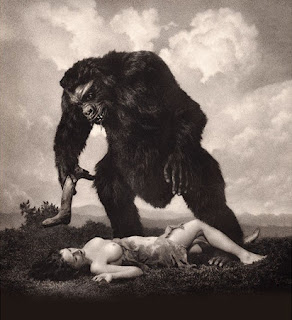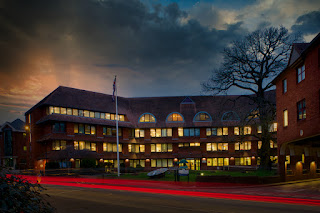L'Amour (1935)
As the debate on AI generated images is currently intensive, I thought it would be interesting to revisit an early photographer who was mostly written out of photographic history by the 'purists' such as Ansel Adams and the f64 group because of his photographic manipulations.
Mortensen categorically rejected the use of realism for its own sake, calling it a “blind alley”. Photographs, he said, should be more than just objects of aesthetic beauty to be admired; they should have an effect on the viewer, exploring extreme emotions and inspiring extreme reactions.
Self portrait as the Mad Hatter (1928)
William Mortensen was a controversial photographer whose work challenged the aesthetics of the f64 group, which included prominent photographers such as Ansel Adams. Mortensen's unique style, which relied heavily on manipulation and post-processing techniques, was considered antithetical to the group's emphasis on pure, unadulterated photography. While Mortensen's approach was not widely embraced by the photographic community of his time, his work has garnered renewed interest in recent years, as it has come to be appreciated for its artistic value and innovation.
Born in 1897, Mortensen began his career as a commercial photographer, working in Hollywood and producing portraits of movie stars and other celebrities. In the 1920s, he began to experiment with a range of photographic techniques, including the use of multiple exposures, darkroom manipulation, and other forms of post-processing. Mortensen's photographs often incorporated elements of the grotesque, the surreal, and the supernatural, creating images that were at once eerie, unsettling, and captivating.
Despite his innovative approach, Mortensen was often at odds with the photographic establishment of his time, particularly with the f64 group. Founded by Adams, Edward Weston, and others, the group espoused a philosophy of "straight" photography, which emphasized the use of large-format cameras and sharp focus to capture the world as it appeared. In contrast, Mortensen's work relied on extensive post-processing and manipulation, which was seen as a violation of the purity of the photographic image.
The tension between Mortensen and the f64 group came to a head in the early 1930s, when Mortensen published a book called "The Command to Look." In this book, Mortensen argued that photography should be seen as an art form, and that photographers should be free to manipulate their images in any way they saw fit. He also criticized the f64 group for their narrow definition of photography, arguing that they were stifling artistic innovation and creativity.
The controversy surrounding Mortensen's work continued throughout his career, with many photographers and critics dismissing his images as mere curiosities or grotesque aberrations. However, in recent years, there has been a growing appreciation for Mortensen's contributions to the art of photography, and his work has been featured in major exhibitions and retrospectives around the world.
The controversy surrounding Mortensen's work can be seen as a precursor to many of the debates that are taking place today around the use of artificial intelligence in creative fields. Just as Mortensen's post-processing techniques challenged the traditional norms of photography, AI is challenging the traditional boundaries between human creativity and machine intelligence. Some argue that AI-generated art is not "real" art, and that it lacks the depth, nuance, and emotional resonance of human-generated art. Others see AI as a tool that can expand the boundaries of creativity and allow us to explore new forms of expression and innovation.
Like Mortensen's work, AI-generated art is often dismissed as a novelty or a gimmick, and many critics are skeptical of its artistic value. However, as we continue to explore the potential of AI in creative fields, it is clear that these debates will only intensify. As Mortensen himself argued, the definition of art is constantly evolving, and we must be open to new ideas and new forms of expression if we are to continue to push the boundaries of creativity and innovation.
The debate goes on...
Off for the Sabbot (1927)





























